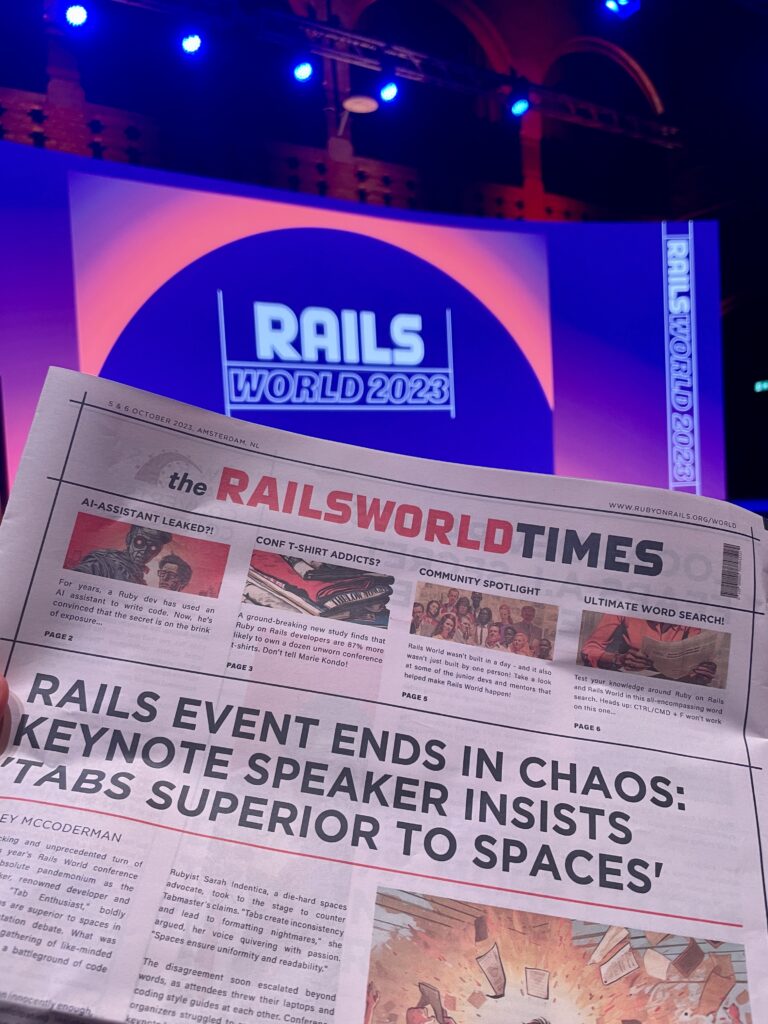Content
20 years ago, Rails released the first version of their project. With their convention over configuration, code contributions from six thousand people, and their full-stack web application framework, they have inspired countless other web frameworks.
Fast forward to 2023, the first RailsWorld conference took place in Amsterdam, celebrating their 20-year anniversary. It sold out in 45 minutes, confirming the high demand for a conference focused solely on Rails.
A two-day community conference, RailsWorld featured technical talks, demos, workshops, networking, and keynotes about the latest features and best practices in Rails development. 700+ Rails developers and 29 speakers contributed to making this a birthday celebration to remember.
The Renaissance Developer by Rails creator
The most powerful presentation came from Rails creator DHH himself, who has a vision and is not afraid of experimentation and bold moves – such as TypeScript dropped in Turbo.
Rails empowers developers to quickly ship apps, without waiting for back-end or front-end engineers. With tools like Hotwire, Strada (just released), and Kamal, more batteries are included to make it a one-person framework.
In fact, at primehammer, it only takes one single engineer to expand and maintain an app handling tens of millions of dollars worth of transactions.
Going Slim: cheaper and faster
Do all projects need an additional key-store like Redis for caching and scheduling background jobs? With the increasing speed of disks such as NVMe SSD, it turns out SSD can compete with in-memory cache stores like Redis. The Rails team just open sourced Solid Cache – a disk–based cache store that is cheaper and faster. Company 37signals has already noticed a 40% increase in speed when displaying emails – and it’s cheaper to run.
Also, you can replace key-value stores like Redis for background jobs with persistent databases – meet Solid Queue. It hasn’t been released yet, but you can use GoodJob for now.
Basically, when running on Heroku/Render, you can drop the Redis service to save some $.
Some members of the dev community are taking this even further, building their next apps with SQLite instead of Postgres, so we are excited about possible upcoming support. Check out the all in one data infrastructure gem litestack.
Blurring the lines between mobile and web
The Rails team sets the right focus on the front-end part and doubles down on HTML over wire technology. This eliminates the need for React-like SPA on the web (and mobile) most of the time. Plus, Strada is finally here after years of waiting, creating a bridge between the native and web app, and the Hey app already serves as an asset with import maps, with no compilation, minification, or transpilation needed.
But there is more: We are thrilled about the upcoming morphing in Turbo 8 – a feature that is already an HTMX extension. This will allow smoother page updates without losing scroll position. Prophaft is also under construction, and its motto is “the best bundling is no bundling”.
My sense is that the Rails team’s focus is on the pain points, such as overcomplicated front-end development and tooling while leveraging shift to new technologies (HTTP2, SSD). It’s adding more batteries to get you started, while giving you blueprints to scale the app as it grows.
Final takeaway: the conference was super awesome and we recommend getting tickets next year!
